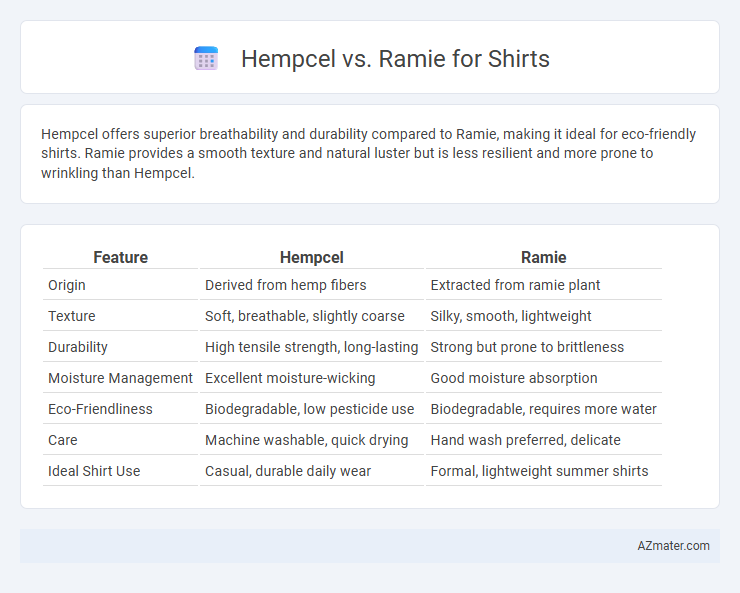Hempcel offers superior breathability and durability compared to Ramie, making it ideal for eco-friendly shirts. Ramie provides a smooth texture and natural luster but is less resilient and more prone to wrinkling than Hempcel.
Table of Comparison
| Feature | Hempcel | Ramie |
|---|---|---|
| Origin | Derived from hemp fibers | Extracted from ramie plant |
| Texture | Soft, breathable, slightly coarse | Silky, smooth, lightweight |
| Durability | High tensile strength, long-lasting | Strong but prone to brittleness |
| Moisture Management | Excellent moisture-wicking | Good moisture absorption |
| Eco-Friendliness | Biodegradable, low pesticide use | Biodegradable, requires more water |
| Care | Machine washable, quick drying | Hand wash preferred, delicate |
| Ideal Shirt Use | Casual, durable daily wear | Formal, lightweight summer shirts |
Introduction to Natural Fiber Shirts
Natural fiber shirts made from Hempcel and Ramie offer exceptional breathability and durability, making them ideal for sustainable fashion. Hempcel fibers are known for their strength, antimicrobial properties, and resistance to UV rays, while Ramie provides a silky texture and excellent moisture absorption. Both fibers contribute to eco-friendly garments with natural resistance to wrinkles and enhanced comfort in warm climates.
What is Hempcel?
Hempcel is a sustainable fabric made from hemp fibers combined with cellulose, offering a soft yet durable texture ideal for shirts. It is known for its moisture-wicking, breathability, and natural antibacterial properties, making it suitable for comfortable, eco-friendly clothing. Compared to ramie, Hempcel provides a unique blend of strength and softness, enhancing shirt performance while supporting environmental sustainability.
What is Ramie?
Ramie is a natural fiber derived from the stalks of the Boehmeria plant, known for its high tensile strength and lustrous appearance. Often compared to hempcel, ramie offers excellent breathability and moisture-wicking properties, making it ideal for lightweight, durable shirts. Its resistance to wrinkles and ability to hold shape contribute to long-lasting, comfortable apparel.
Sustainability Comparison: Hempcel vs Ramie
Hempcel and ramie fibers both offer sustainable options for shirt fabrics, with hempcel derived from hemp plants known for rapid growth and low water usage, minimizing environmental impact. Ramie, a bast fiber from the ramie plant, requires chemical processing that may affect its eco-friendliness despite its biodegradability and durability. In sustainability comparisons, hempcel typically ranks higher due to its organic cultivation, minimal pesticide needs, and efficient land use, making it the preferred choice for eco-conscious apparel producers.
Durability and Longevity
Hempcel shirts offer superior durability due to hemp fibers' natural resistance to wear and tear, making them ideal for long-lasting garments. Ramie shirts, while strong from its linen-like texture, tend to be less resilient under repeated stress compared to hemp. The high tensile strength and antibacterial properties of hemp enhance shirt longevity, maintaining fabric integrity and resistance to stretching or shrinking over time.
Comfort and Breathability
Hempcel shirts offer superior breathability due to their natural fiber structure, which promotes air circulation and moisture wicking, making them comfortable for extended wear in warm climates. Ramie fabric provides a smooth, lightweight texture that feels cool against the skin, though it tends to be less breathable than hempcel because of its denser weave. Comfort in hempcel shirts is enhanced by their softness that increases with washing, while ramie retains a crisp finish but can feel stiffer initially.
Moisture Wicking Abilities
Hempcel fibers exhibit superior moisture-wicking properties due to their natural hollow structure, which enhances breathability and quickly draws sweat away from the body, keeping the wearer dry and comfortable. Ramie, while strong and durable, has a denser fiber composition that does not absorb or wick moisture as efficiently as Hempcel, often leading to slower drying times in shirts. For moisture management in activewear or warm climates, Hempcel-based shirts outperform Ramie, offering improved ventilation and moisture control.
Aesthetic and Care Considerations
Hempcel shirts offer a natural matte finish with subtle texture that softens over time, enhancing their rustic aesthetic, while Ramie shirts present a smooth, lustrous appearance with vibrant color retention, ideal for polished and lightweight garments. Hempcel fabric is highly durable, resistant to UV rays, and becomes more comfortable with each wash, requiring gentle care to maintain its softness and prevent shrinkage. Ramie, though strong and breathable, demands delicate laundering to avoid brittleness and preserve its sheen, necessitating careful washing and air drying to sustain its aesthetic appeal.
Cost and Accessibility
Hempcel fabric typically costs more than ramie due to its sustainable production process and limited availability, making it a premium choice for eco-conscious consumers. Ramie fabric is more affordable and widely accessible, benefiting from established farming and processing infrastructure. Both materials offer durability, but hempcel's price point may restrict its use to niche markets while ramie's cost-effectiveness supports mass production.
Conclusion: Choosing Between Hempcel and Ramie
Hempcel offers superior moisture-wicking properties and durability, making it ideal for activewear shirts, while ramie provides a silk-like texture and excellent breathability suited for casual and formal shirts. Both fibers are eco-friendly and biodegradable, but hempcel's natural resistance to UV rays and mold makes it a more versatile choice for outdoor use. Selecting between hempcel and ramie depends on the shirt's intended function, with hempcel favored for performance and ramie preferred for comfort and aesthetics.

Infographic: Hempcel vs Ramie for Shirt
 azmater.com
azmater.com